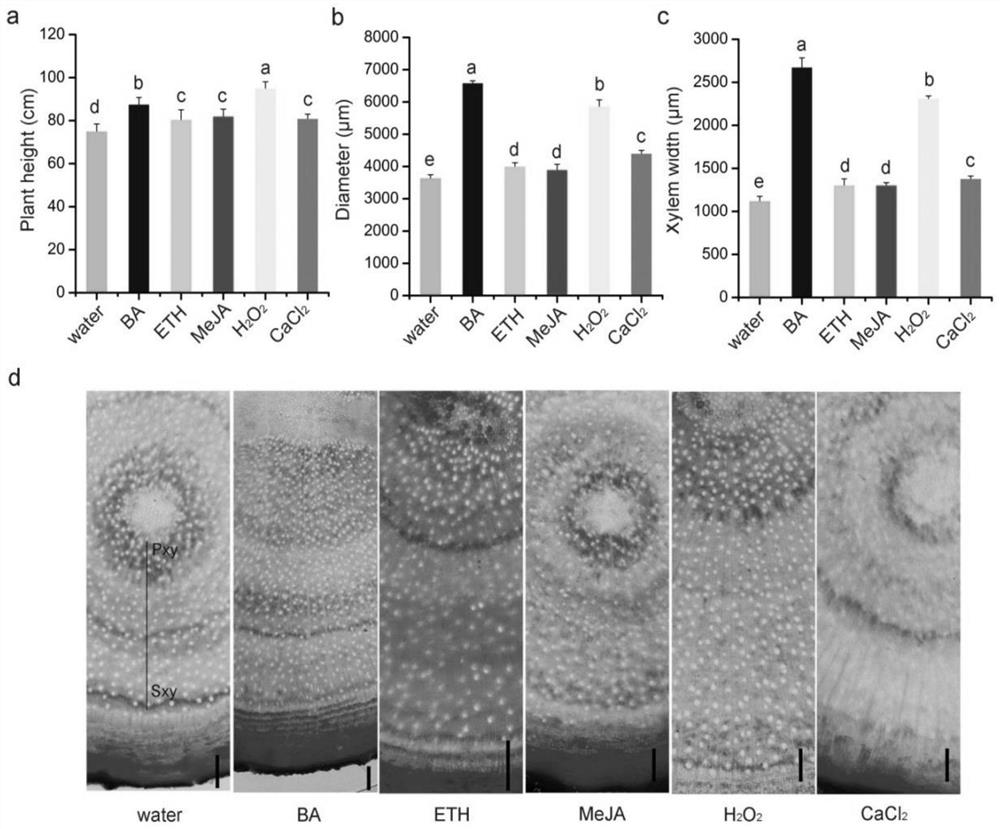Application of chemical inducers in promoting growth and development of sandalwood seedling stems
A chemical induction, growth and development technology, applied in the fields of application, botany equipment and methods, horticulture, etc., can solve the problems of lack of young sandalwood research and unavailable information
- Summary
- Abstract
- Description
- Claims
- Application Information
AI Technical Summary
Problems solved by technology
Method used
Image
Examples
Embodiment 1
[0023] 1. Materials and methods
[0024] 1. Plant growth conditions and material selection
[0025] First, soak the plump seeds of sandalwood (Santalum album L.) (after removing the aril) in 2mM gibberellin solution for 12 hours, then disinfect the surface of the seeds with 3% sodium hypochlorite solution for 5 minutes, rinse with distilled water for 3 times , sow in sterile sand in pots in a nursery (ambient temperature: 27-32° C.). After the seeds germinate and the seedlings grow at least 4 leaves (it takes about 1 month to 1.5 months), move the 10cm high seedlings into a 14cm×11cm plastic container filled with a mixture of loess and humus (5:1, v / v). Pots, placed in a shady shed. After 1 month, the seedlings were cultured together with the host Artemisia annua. When the seedlings grew to more than 30 cm, the seedlings and their hosts, Artemisia annua, were transferred to a 25 cm × 30 cm cloth bag filled with a mixture of loess and humus (5:1, v / v) to continue culturing. ...
Embodiment 2
[0051] 1. Materials and methods
[0052] 1. Test materials and drugs
[0053] The sandalwood for testing was planted in 2010, and the early hosts were mainly sandalwood such as Miruihua, Jiulixiang, and Neem. The row spacing was about 2m×2m, and the test plot was a flat terrain with good drainage.
[0054] In October 2015, 44 sandalwood trees with similar growth, diameter at breast height of 6-7cm, and heartwood had not yet formed were randomly selected in the test site for testing.
[0055] The tested drugs are: 6-Benzylaminopurine (6-Benzylaminopurine, BA) (~99%), Shanghai Yika Biotechnology Co., Ltd.; Ethephon (ETH) (≥85%), Beijing Suolaibao Technology Limited; 30% H 2 o 2 (Analytical grade), Sinopharm Chemical Reagent Co., Ltd.; Calcium Chloride (>99%), Beijing Combis Technology Co., Ltd.; Methyl jasmonate (MeJ) (95%), Aladdin Reagent (Shanghai) Ltd. Each drug has two concentrations of 2mM and 4mM, and the dosage is about 400ml / time, 4 times a year. See Table 1 for r...
PUM
 Login to View More
Login to View More Abstract
Description
Claims
Application Information
 Login to View More
Login to View More - R&D
- Intellectual Property
- Life Sciences
- Materials
- Tech Scout
- Unparalleled Data Quality
- Higher Quality Content
- 60% Fewer Hallucinations
Browse by: Latest US Patents, China's latest patents, Technical Efficacy Thesaurus, Application Domain, Technology Topic, Popular Technical Reports.
© 2025 PatSnap. All rights reserved.Legal|Privacy policy|Modern Slavery Act Transparency Statement|Sitemap|About US| Contact US: help@patsnap.com



